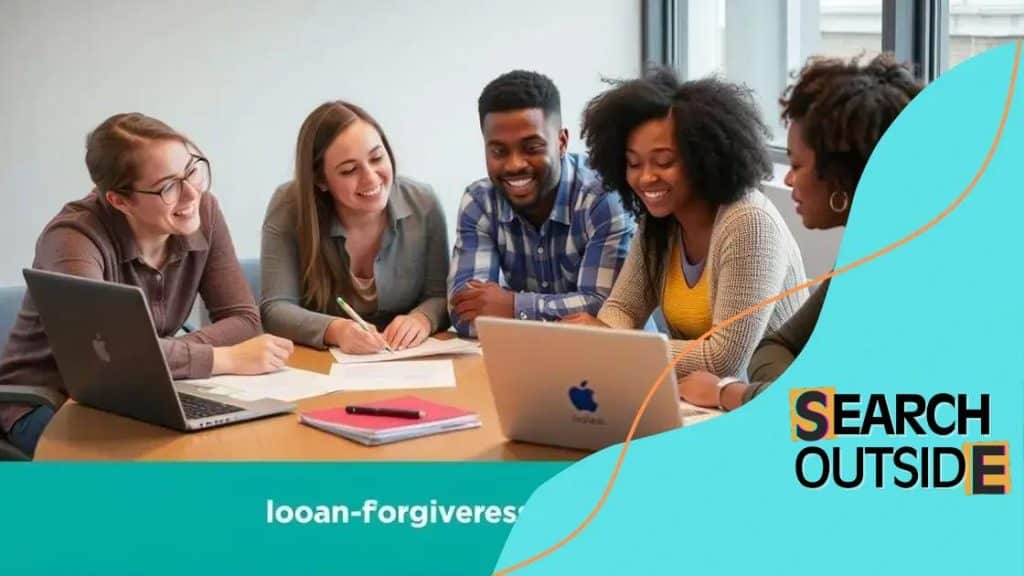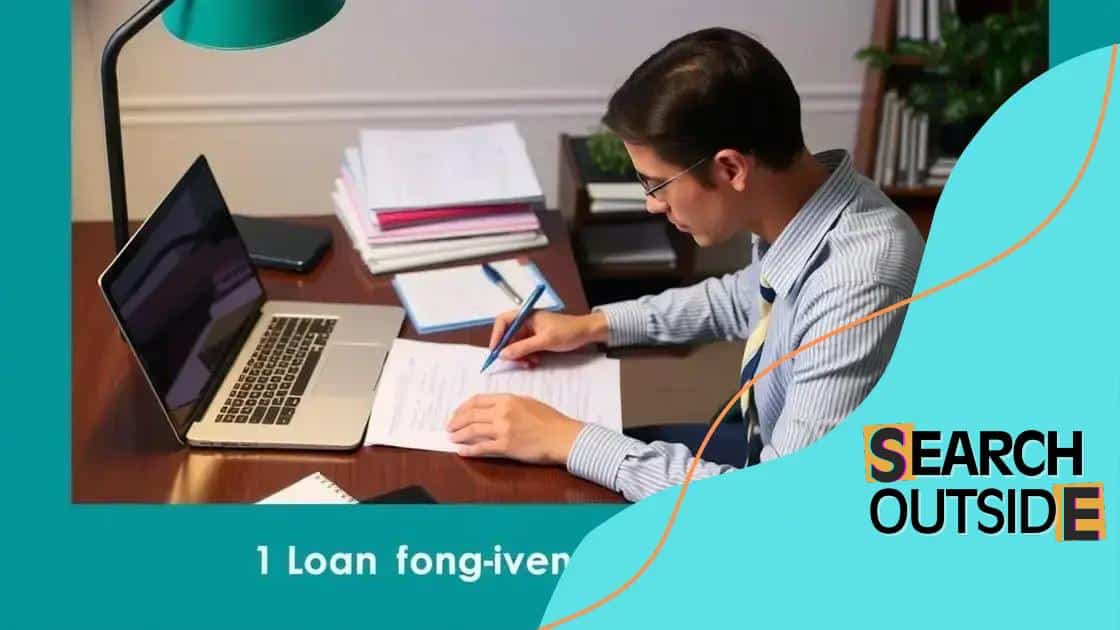How to apply for federal student loan forgiveness

To apply for federal student loan forgiveness, gather necessary documents, ensure you meet eligibility criteria, and submit a complete application before the deadline while avoiding common mistakes.
If you’re wondering how to apply for federal student loan forgiveness, you’re not alone. Many borrowers seek ways to ease their financial load. Here, we dive into the essentials to guide you through this process.
Understanding federal student loan forgiveness programs
Understanding federal student loan forgiveness programs is essential for borrowers looking to reduce their debt. These programs can provide significant relief, but it’s crucial to know how they work.
Types of Federal Student Loan Forgiveness
There are several types of forgiveness programs tailored to different careers and situations. Each program has unique eligibility requirements.
- Public Service Loan Forgiveness (PSLF): This program is for individuals who work in public service jobs, including non-profits and government agencies.
- Teacher Loan Forgiveness: Teachers who work in low-income schools may qualify for forgiveness after five years.
- Income-Driven Repayment (IDR) Forgiveness: After 20 or 25 years of qualifying payments, borrowers can have their remaining balance forgiven.
Knowing the type of program that fits your situation can lead to more significant financial relief. Furthermore, understanding the potential impact of these programs on your credit score and overall financial health is vital.
How to Apply for Forgiveness
Applying for forgiveness involves specific steps and documentation. You will need to submit the necessary forms and keep track of your progress. It’s essential to maintain accurate records of your payments, employment, and any correspondence related to your loans.
For PSLF, for example, you must submit the Employment Certification Form annually. This helps ensure your qualifying payments count towards forgiveness. Similarly, teachers need to fulfill their service requirements to be eligible for Teacher Loan Forgiveness.
Before applying, review each program’s criteria. This can save you time and maximize your chances of achieving forgiveness.
In summary, understanding federal student loan forgiveness programs is critical for managing your student debt. By familiarizing yourself with the available options and requirements, you can make informed decisions that lead to financial freedom.
Eligibility criteria for forgiveness
The eligibility criteria for forgiveness is a key aspect for borrowers seeking relief from their federal student loans. Knowing if you qualify can save you time and effort in the application process.
General Requirements
Most programs have specific requirements that individuals must meet to be eligible. Generally, you need to be a borrower of federal loans, and your loans must be in good standing.
- Qualified Loans: Ensure that your loan type is eligible for forgiveness. Not all loans qualify.
- Payment History: You often need to show a history of on-time payments to qualify.
- Employment Status: Your job may play a significant role in your eligibility for certain programs.
For instance, under the Public Service Loan Forgiveness program, you must be employed full-time in a qualifying public service job. This means working for non-profit organizations or government agencies. However, if you work in a for-profit sector, you won’t qualify.
Special Circumstances
Sometimes, special circumstances can affect your eligibility. Situations like temporary disabilities or certain financial hardships may allow for exceptions. Moreover, knowing the specific documentation needed can help streamline your application process.
Always keep in mind that the eligibility criteria can vary widely by programs. For example, if you are a teacher, there are unique qualifications you must meet to access the Teacher Loan Forgiveness program.
Reviewing these criteria not only helps in determining your likelihood of qualifying but also prepares you for the necessary steps to gain forgiveness successfully.
Step-by-step application process

The step-by-step application process is crucial for anyone seeking to benefit from federal student loan forgiveness. Understanding each phase can help you avoid delays.
Gather Necessary Documents
Begin by collecting all relevant documentation. This includes your loan information and proof of employment. Having everything organized will simplify your application process.
- Loan Statements: Make sure you have the latest statements for all federal loans.
- Employment Certification: Obtain forms from your employer that show you work in a qualifying position.
- Pay Stubs: Keep recent pay stubs to demonstrate your income status.
After gathering documents, you can start filling out your application. It’s important to follow the specific guidelines provided by the forgiveness program you are applying for.
Complete the Application Form
Next, complete the application form accurately. Carefully read every section and ensure you fill in the required details without errors.
Once your application form is ready, double-check all your information. A small mistake can cause delays in processing. Ensure that your contact information is correct to receive updates.
Submit Your Application
After completing the application, submit it according to the program instructions. Some programs allow online submissions, while others may require you to send documents via mail. Choose the method that fits your needs.
Be sure to keep copies of all your submitted documents. This will be helpful should you need to reference them later or if any issues arise.
After submission, monitor your application status. Many programs provide online tools to check your progress. Being proactive can help you stay informed and address any problems quickly.
Necessary documentation for your application
Having the necessary documentation for your application is a vital step in the process of applying for federal student loan forgiveness. Accurate documents help ensure your application is processed without delays.
Essential Documents
Start by gathering key documents related to your student loans. This includes the following:
- Loan Information: Have your most recent statements which list all of your federal loans.
- Proof of Employment: Documentation that verifies your work status, especially if you qualify for programs like Public Service Loan Forgiveness.
- Tax Returns: Most programs require income verification, so having your recent tax returns is important.
Each of these documents plays a crucial role in supporting your eligibility. Organizing them can simplify the application process significantly.
Additional Supportive Documents
Depending on the program you are applying for, additional documents might also be necessary. Consider obtaining your salary stubs to demonstrate your income, especially if you’re applying under an income-driven repayment plan.
Furthermore, if you’re a teacher applying for forgiveness, documents proving your teaching service and the school’s low-income status can be helpful. Keeping everything organized will allow your application to move through the system more smoothly.
Also, make copies of all submitted documents. This ensures you have a record of what you applied with. Being prepared can ease potential stress during the waiting period after submission.
Common pitfalls to avoid during the application
Avoiding common pitfalls during the application process is essential for increasing your chances of successfully obtaining federal student loan forgiveness. While the process can seem straightforward, many applicants make errors that can delay or derail their applications.
Incomplete Applications
One of the most frequent mistakes is submitting incomplete applications. Failing to fill out all required sections or omitting necessary documentation can lead to automatic rejection.
- Double-check your forms: Make sure every section is filled out accurately.
- Attach required documents: Missing documents can halt your application.
- Follow instructions carefully: Each program may have different requirements.
Being thorough and attentive to details will help you avoid these common issues.
Missed Deadlines
Another critical pitfall is missing application deadlines. Each forgiveness program has specific time frames for submission.
Keep track of important dates on your calendar and set reminders. Whether you are applying for the Public Service Loan Forgiveness program or another option, knowing the deadlines is crucial for timely submission.
Neglecting to Stay Informed
Federal student loan policies can change. Not staying up-to-date means you may miss out on new options or requirements.
It’s important to regularly check official resources and websites related to your loans. Join online forums or groups to connect with other borrowers who can share insights and updates.
By actively engaging with your loan services and following the latest news, you can steer clear of potential misunderstandings.
Being aware of these pitfalls not only enhances your application experience but also greatly increases your chances of receiving forgiveness.
In conclusion, understanding the process of applying for federal student loan forgiveness can significantly ease your financial burdens. By familiarizing yourself with the eligibility criteria, gathering the necessary documents, and avoiding common pitfalls, you can enhance your chances of success. Remember to stay informed about any changes in federal policies and keep track of deadlines. With the right steps and diligence, you can take a meaningful step toward financial freedom.
FAQ – Frequently Asked Questions about Federal Student Loan Forgiveness
What types of loans are eligible for forgiveness?
Most federal student loans, including Direct Loans and certain FFEL loans, are eligible for forgiveness. Private loans do not qualify.
How long does the forgiveness process take?
The process can take several months, depending on the program and the completeness of your application.
Can I apply for forgiveness if I’m still in school?
You generally cannot apply for forgiveness while you are still enrolled in school unless you meet specific requirements, such as teaching in a low-income area.
What happens if my application is denied?
If your application is denied, you will receive a notification explaining the reasons and have the opportunity to appeal the decision.





